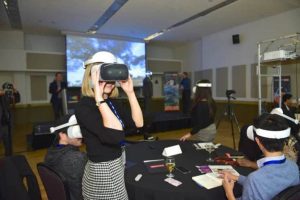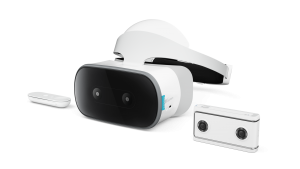You may never ever want to get this close to a lion, but by doing so, you will never ever forget that life is worth protecting, no matter whose.

Virtual field trips in the wilderness are supported by famed naturalist Jane Goodall and Lenovo. Image: Wild Immersion
Thanks to the power of virtual reality (VR), the creativity of folks like those working on the Wild Immersion project, and the capable technology developed by companies like Lenovo, we can learn a lot about the lion and not get eaten.
Virtual reality has been identified as an important growth area by a number of leading technology companies, and recently Lenovo underscored the value of VR as a learning tool by launching a dedicated kit for using virtual reality in the classroom.
Lenovo includes wireless VR headsets in its new classroom kits, created specifically for students in grades 7 to 12, and they are preloaded with incredible content, including some amazing virtual field trips endorsed by famed naturalist and primatologist Jane Goodall, taking students to a virtual reserve of animals from around the world.
The Wild Immersion VR program is dedicated to delivering a strong educational message about nature and species extinctions, and it is creating dozens of VR video programs and supplementary content particularly so that younger generations can become informed and hopefully engaged.
Lenovo’s standalone headset, the Mirage Solo, is great in a classroom environment (and other places) precisely because it delivers VR experiences without cables attached to computers.

Lenovo underscores the value of VR as a learning tool by launching a dedicated kit for using virtual reality in the classroom. Image: CNW Group/Lenovo
Not only is VR a fun experience for students, the classroom is often the first place young people can have the opportunity to put a headset on and try VR for any purpose. The new perspectives and different perceptions students get when they enter an immersive, 360°, 3-D virtual space always generates enthusiasm, and the experience quite often leads to an increase in student engagement with a topic and a strong motivation to learn more.
Even better, some students show an increased retention of the information that’s presented because passive learning experiences – some would say boring classes – are turned active learning experiences.
As Lenovo, Goodall and Wild Immersion have shown, good VR content can eliminate the need for people to be physically present in order to learn, and topics that once depended on hands-on learning can be made more accessible in a virtual environment.
Subjects like biology and physics can come alive in VR, and the learning opportunities in other topics increase as well: a recent study by the U.S.-based educational research firm Foundry10 showed that 44 per cent of surveyed students were interested in using VR for science education, 38 per cent for history education, with English, math and the arts following up.
(Among the VR-enabled learning opportunities not delivered in a school setting are those found in art galleries, museums and science centres. For example, WhatsYourTech has reported on digital technology and sophisticated software programs have helped uncover the big ideas behind some very small artwork, in what’s been dubbed the first true use of virtual reality in art galleries and museums. From a more scientific perspective, the VR sequences and video obtained during some remarkable deep ocean voyages are gorgeous, but the deeper story is, well, pretty ugly: our oceans have been pushed into a state of extreme disruption.)
Content is key to the success of VR as an educational tool, of course, and that’s why Lenovo is delivering curriculum-derived educational content with its kits. VR videos from the Wild Immersion endorsed by Jane Goodall come alongside custom scholastic content and STEM-derived lesson plans.
Usually, lessons for the classroom are created and presented in a traditional, linear way – information is delivered following a predictable trajectory from one fact to the next. But immersive virtual reality jumbles up that notion by breaking the need for linear content delivery. Students will take pretty much any path they can from one fact to another and it is up to instructional designers and VR programmers to anticipate and accommodate very different user needs and learning styles.
Of course, VR learning experiences can be repeated as many times as needed to make sure that there’s a solid grasp of the information presented and a good appreciation of the content and context.
Teachers in a VR-equipped classroom must therefore figure out how to structure their lessons and conduct their classes in a way that makes best use of the technology, but also incorporates in-person instruction in ways that are the most effective in reaching particular training goals or learning objectives for individual students.
Lenovo’s roll-out of VR Classroom kits comes support for teachers through onboarding sessions, ongoing training and a bilingual helpdesk.

Lenovo is providing classroom VR kits, which include headsets preloaded with some 700 field trips and integrated lesson plans. Image: CNW Group/Lenovo
The kit (available three, ten or 24 packs) lets teachers take students through lesson plans together. VR content is delivered using Lenovo’s standalone Mirage Solo, the all-in-one wireless VR headset with Google Daydream, which means no tethered cables, PCs or smartphones, a hand controller for increased interactivity, motion-tracking technology and 110-degree field view so that students can more freely discover the world around them.
While Lenovo keys in on the students in grades 7 to 12, another tech company in the VR space, Cisco, has launched its Education Room in its Innovation Centre, focused on the possibilities of emerging technology that can be used in universities and colleges.
While reviewing some of the latest technologies that schools could potentially use in the future, analysts noted that some education systems can gather and track student analytics.
Learning systems that allow Wi-Fi connections (in the classroom, or even across the campus) can be used to understand how students interact with the learning experience and course material. But the technology can also be used to collect and interact with data about students’ attendance in class, their time spent in the library or attending other events on campus, and analyze the data in real-time.
In the technologically enabled classroom, students can therefore learn that their personal data, like our precarious natural environment, needs real protection.
-30-
Related: Virtual Reality



